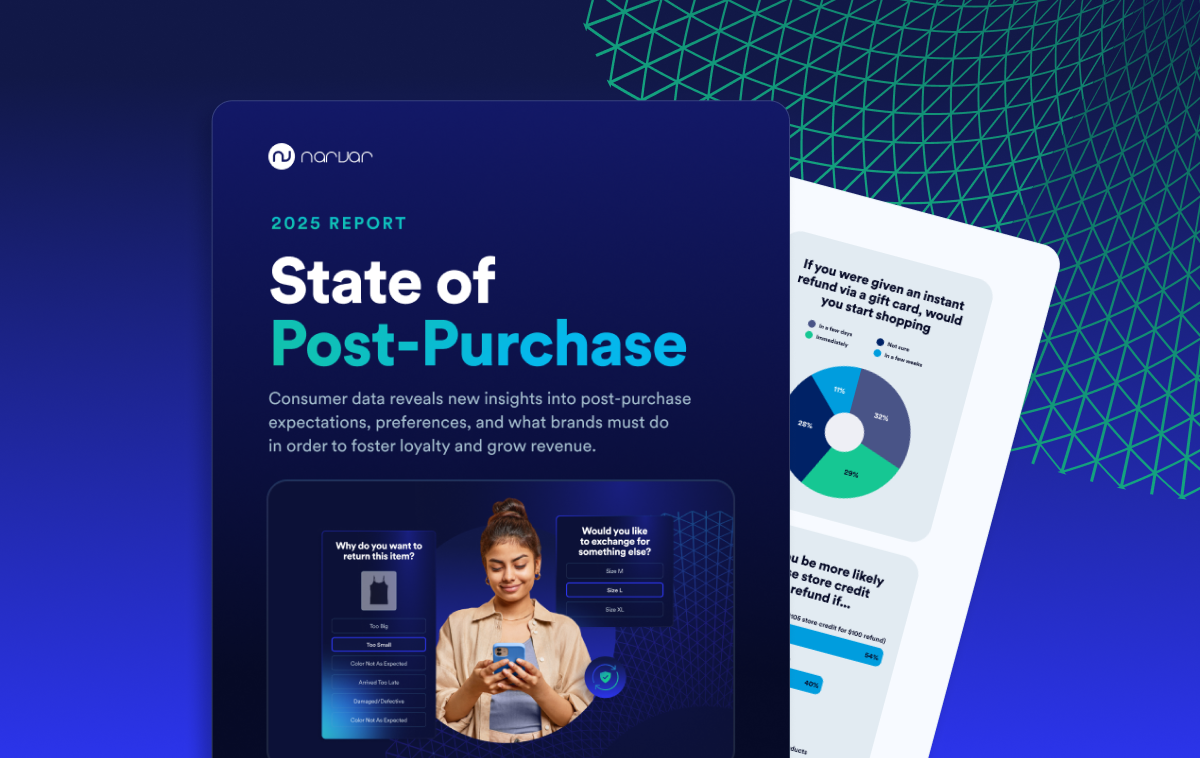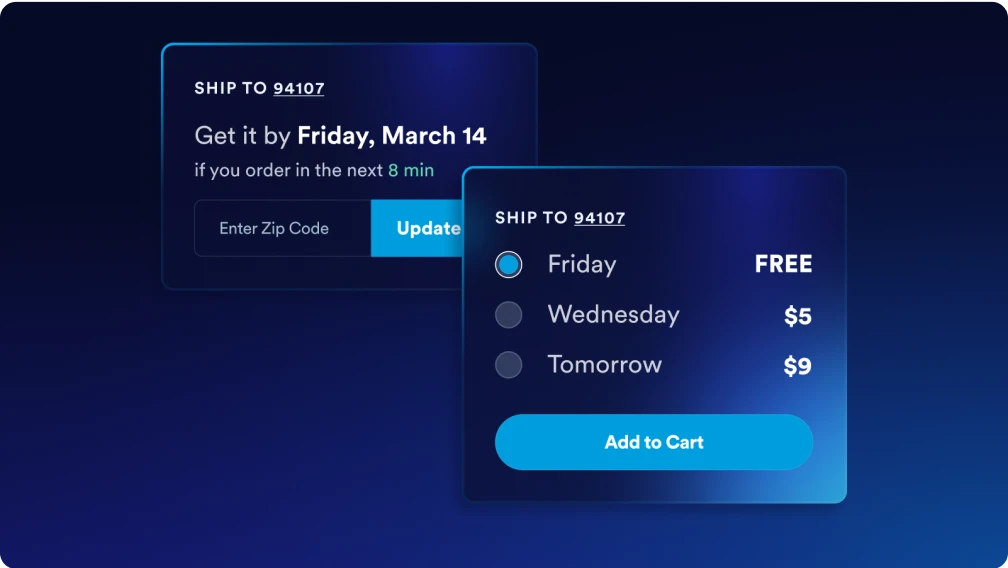
AI-powered delivery date estimates to boost conversion
Give shoppers peace of mind and protect and grow your bottom line
Personalized tracking experiences to build brand loyalty
Returns and exchanges management to mitigate fraud and reward best customers
Proactive communication to drive customer lifetime value
Delivery claim management to tackle fraud and build trust
Accuracy Beats Cost: Why Precise Estimated Delivery Dates Boost Conversion

Narvar’s 2025 State of Post-Purchase Report finds that accuracy outranks cost when deciding to hit "buy."
In a landscape where delays are increasingly common, accuracy has become the deciding factor in whether a consumer completes a purchase, returns to a retailer, or walks away entirely. In fact, consumers care more about knowing when their order will arrive than how much it costs to get it there.
In our 2025 State of Post-Purchase Report, we surveyed 3,461 U.S. consumers and found that while cost and speed matter when it comes to delivery timing and estimates, delivery accuracy is what ultimately earns customer trust and inspires repeat purchases.


Learn What Consumers Want “Beyond Buy”
In our 2025 State of Post-Purchase Report, we explore what reassures, delights, and re-engages consumers — and how retailers can create experiences that drive revenue and loyalty.
Trust is critical to retail success
Let’s take a step back and explore why trust is so important for retailers.
Trust builds loyalty: 88% of consumers need to trust a brand to consider buying from it. And loyal shoppers don’t just come back — they spend more, convert more, and drive the bulk of long-term revenue. In fact, returning shoppers spend 67% more than new ones.
That’s why protecting the consumer experience matters more than one-off discounts or campaigns.
Shoppers will leave after one late delivery
Delivery promises are where retailers build or break consumer trust. Our survey found that a missed delivery date dissolves confidence in the brand behind it. Half of consumers say they’re less likely to shop again after a late delivery, and 6% cut ties for good.
For younger shoppers, the stakes are even higher. Among consumers ages 18 – 29, 60% say they won’t shop again after a late delivery — proving that for a generation raised on real-time tracking and instant gratification, patience is no longer part of the purchase.
Not every retailer draws the same level of scrutiny from today’s shoppers. Mid-market brands face the steepest consequences.
“Would a late delivery affect my relationship with a brand? It depends on the company. It doesn't affect my relationship with Amazon, but possibly a midsized retailer.”
— Consumer survey respondent
Big-name players may survive a stumble, but emerging and mid-sized retailers don’t have that luxury. When your brand promise hinges on reliability, one broken commitment can push consumers straight into the arms of your competitors.
But late deliveries are commonplace
Unfortunately, late deliveries have become less of an anomaly — and more of an everyday reality. In fact, we found 74% of consumers received a package later than the estimated delivery date in the past year.
This aligns with the fact that on-time delivery rates are declining for the Big 3 carriers. During the 2024 holiday season, on-time delivery rates fell across all three: USPS (90% vs. 97% the year before), FedEx (92% vs. 98%), and UPS (97% vs. 99%).
The culprit? Volume. The Pitney Bowes Parcel Shipping Index shows that U.S. parcel shipments reached 22.37 billion in 2024 — nearly double the 11.5 billion shipped in 2016. Every extra package adds strain to already-tight delivery networks, making accurate promises harder to keep.
For shoppers, this uncertainty creates friction long before the package arrives. Two-thirds of consumers feel anxious when clicking “buy,” and 34% worry their order will arrive late. That means brands aren’t just fighting logistics delays. They’re fighting perception.
Consumers demand accuracy
In a market where late deliveries have become the norm, accuracy is the new differentiator. The retailers who can make delivery dates as dependable as their products will be the ones who earn trust long after checkout.
Our survey found that when consumers evaluate shipping options and delivery estimates, accuracy even outranks cost (57% vs. 56%) — proof that shoppers value certainty more than a few saved dollars.
Accuracy outranks cost as the most-important factor in choosing a delivery option at checkout (57% vs. 56%).
Accuracy also has a powerful psychological impact. For example, 35% of consumers say that accurate delivery dates would ease their post-purchase anxiety, transforming what’s often a tense waiting period into one of confidence and anticipation.
And that trust pays dividends. More than half of shoppers (55%) say that on-time delivery would make them more likely to buy from a retailer again, making it the single strongest loyalty driver identified in our survey. In fact, 37% of consumers would pay extra just to guarantee an on-time arrival, signaling that confidence is currency.
37% of consumers would pay extra to guarantee on-time delivery.
In other words, accuracy isn’t just operational excellence — it’s emotional assurance. It tells consumers your brand delivers on its promises, literally and figuratively. And in a landscape full of uncertainty, that reliability might just be your biggest competitive advantage.
So, how can retailers make sure their delivery date estimates are accurate?
How to provide accurate estimated delivery dates (EDD) that build consumer trust
Let’s explore five proven strategies for improving the accuracy of your delivery estimates and, ultimately, reducing cart abandonment.
Tactic #1: Use AI-powered EDD solutions
Look for platforms that go beyond static delivery windows and instead continuously learn and adapt. The most effective tools leverage machine learning to account for variables like fulfillment patterns, carrier performance, and seasonal shifts — enabling delivery date accuracy of 95% or higher.
Tactic #2: Find an EDD solution with built-in flexibility
An ideal solution should also offer flexibility in how the EDD is presented. Whether it’s a confident single date, a broader range, or no date at all when uncertainty is high, smart systems personalize the delivery promise to reflect real-world conditions.
You want an EDD solution that can easily flex and adapt during extenuating circumstances (think: peak season, weather or carrier delays, etc.). When necessary, you should be able to implement manual overrides to quickly adapt and minimize consumer impact.
Tactic #3: Find a partner committed to precision and conversion
Ask your providers about their reporting and analytics. You want a partner that will continue to optimize both delivery accuracy and website conversions.
Features like built-in A/B testing can help optimize for conversion without sacrificing accuracy, and the ability to layer in custom business rules ensures alignment with operational constraints.
Tactic #4: Audit fulfillment times to understand realistic SLAs
Accurate delivery promises depend on knowing what your operation can actually deliver. Audit your fulfillment times regularly to ensure SLAs reflect real performance, not best-case scenarios. Identify bottlenecks and adjust EDDs accordingly to prevent overpromising and underdelivering.
And don’t forget to prioritize — expedited orders, VIP shoppers, and high-value shipments should move to the front of the line. When your fulfillment SLAs mirror reality and your priorities are clear, accuracy and trust naturally follow.
Tactic #5: Communicate delays before consumers do
Despite a retailer’s best efforts, sometimes late deliveries happen. But how you respond determines whether you protect loyalty — or put your business at risk.
The good news? Consumers can handle bad news as long as you proactively communicate and address the issue(s). And, this communication can — and should — be automated for efficient, effective issue resolution. For example, 38% of shoppers say more frequent tracking updates would reduce their shopping anxiety. Program these exceptions into your existing notification workflows to give shoppers the peace of mind that their orders are being taken care of before they have to ask.
Of course, shoppers can always reach out to support, if needed, which reduces anxiety for 39% of shoppers. And consumers have been clear about what exactly helps ease their frustration due to a delivery issue. When it comes to building trust after a delay, 46% of consumers want a message from the brand acknowledging the issue, and another 46% expect a clear explanation of what caused it. Just as important, 45% look for accurate, real-time tracking updates to stay informed.
To preserve the relationship after a late delivery, 37% of consumers say they want fast, free shipping on a future purchase, 36% would appreciate a discount, and 35% want the option of a free return.
Trust is the ultimate competitive advantage
Accuracy has become one of the strongest differentiators in the post-purchase experience. In an environment where late deliveries are common and consumer expectations keep rising, shoppers reward the brands that provide delivery dates they can count on. Accurate EDDs reduce cart abandonment, ease post-purchase anxiety, and strengthen the trust required for long-term loyalty.
The retailers who win aren’t the ones offering the biggest discounts or the fastest-sounding promises — they’re the ones who consistently deliver on the commitments they make. When accuracy becomes part of the brand promise, trust becomes a competitive advantage.

Turn Your Post-purchase Experience into a Competitive Advantage
Chat with a Narvar expert to see how accurate delivery promises, proactive communication, and seamless returns can build trust — and long-term growth.
Related posts



















%20(31).webp)
.png)

